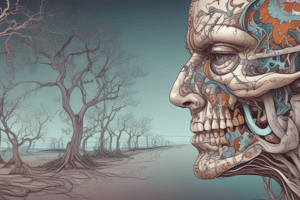Podcast
Questions and Answers
What is the primary role of substance P in the pulp response?
What is the primary role of substance P in the pulp response?
- It decreases the production of arachidonic acid metabolites.
- It serves as a chemotactic and stimulatory agent for immune cells. (correct)
- It acts solely as a vasodilator.
- It inhibits the production of cytokines.
Which neuropeptide is associated with immunosuppressive activity?
Which neuropeptide is associated with immunosuppressive activity?
- Neurokinin A
- Neuropeptide Y
- Calcitonin gene-related peptide (correct)
- Substance P
What is a consequence of the release of neurogenic mediators in response to external stimulation of dentin?
What is a consequence of the release of neurogenic mediators in response to external stimulation of dentin?
- Decreased vascular permeability.
- Stimulation of bone resorption.
- Vasodilatation and increased tissue pressure. (correct)
- Increased production of Class II antigens.
What effect does calcitonin gene-related peptide (CGRP) have on pulp healing?
What effect does calcitonin gene-related peptide (CGRP) have on pulp healing?
Which process is affected by the stimulation of sympathetic nerves in the pulp?
Which process is affected by the stimulation of sympathetic nerves in the pulp?
What interaction might explain gender differences in dental pain presentation?
What interaction might explain gender differences in dental pain presentation?
Which of the following mediators is NOT mentioned as a neurogenic mediator associated with pulp responses?
Which of the following mediators is NOT mentioned as a neurogenic mediator associated with pulp responses?
Which statement best describes the relationship between neurogenic mediators and the immune response in dental pulp?
Which statement best describes the relationship between neurogenic mediators and the immune response in dental pulp?
Flashcards are hidden until you start studying
Study Notes
Neurogenic Mediators in Pulp Response
- Neurogenic mediators are released from pulp afferent nerves in response to external stimulation of dentin.
- These mediators include Substance P (SP), calcitonin gene-related peptide (CGRP), neurokinin A (NKA), neurokinin Y (NKY), and vasoactive intestinal peptide (VIP).
- Neurogenic mediator release can lead to vasodilatation and increased vascular permeability, resulting in elevated tissue pressure that can cause necrosis in extreme cases.
- Stimulation of sympathetic nerves by mediators like norepinephrine, neuropeptide Y, and ATP can alter pulp blood flow (PBF).
- Inflammation can trigger sprouting of afferent fibers, as demonstrated by receptor field and anatomical studies.
Modulation of the Pulp Immune Response
- SP acts as a chemotactic and stimulatory agent for macrophages and T lymphocytes, leading to increased arachidonic acid metabolites, lymphocytic mitosis, and cytokine production.
- CGRP demonstrates immunosuppressive activity by reducing Class II antigen presentation and lymphocyte proliferation.
- SP and CGRP are mitogenic for pulp and odontoblast-like cells, initiating and promoting pulp healing.
- CGRP stimulates the production of bone morphogenic protein by human pulp cells, potentially inducing tertiary dentinogenesis.
Clinical Implications of Neurogenic Mediators
- SP levels increase in the dental pulp and periodontal ligament after acute occlusal trauma, potentially contributing to pain associated with concussion traumatic injury.
- Gender differences in CGRP production have been observed. For example, serotonin induces a more significant increase in capsaicin-evoked CGRP release in dental pulps from females compared to males.
- This interplay of inflammatory mediators may explain some of the gender differences in clinical presentation of dental pain.
- Neurotropic factors like neurogenic mediators are present in dentin matrix and may be released during regenerative procedures, supporting trigeminal neurite growth.
Studying That Suits You
Use AI to generate personalized quizzes and flashcards to suit your learning preferences.




